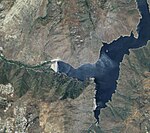Capitan Grande Reservation
1875 establishments in CaliforniaAmerican Indian reservations in CaliforniaBarona Group of Capitan Grande Band of Mission IndiansCuyamaca MountainsEast County (San Diego County) ... and 3 more
Former Native American populated places in CaliforniaKumeyaay populated placesViejas Group of Capitan Grande Band of Mission Indians

The Capitan Grande Reservation is a Kumeyaay Indian reservation in San Diego County, California, jointly controlled by the Barona Group of Capitan Grande Band of Mission Indians and Viejas Group of Capitan Grande Band of Mission Indians. The reservation is uninhabited and is 15,753 acres (63.75 km2) large, located in the Cuyamaca Mountains and middle of the Cleveland National Forest and west of Cuyamaca Peak. The closest town is Alpine, California.
Excerpt from the Wikipedia article Capitan Grande Reservation (License: CC BY-SA 3.0, Authors, Images).Capitan Grande Reservation
El Capitan Road,
Geographical coordinates (GPS) Address Nearby Places Show on map
Geographical coordinates (GPS)
| Latitude | Longitude |
|---|---|
| N 32.925983333333 ° | E -116.72932777778 ° |
Address
El Capitan Road (El Capitan Truck Trail)
El Capitan Road
California, United States
Open on Google Maps








